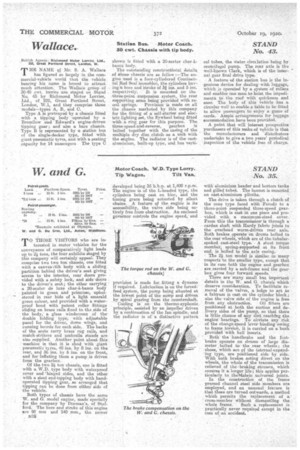W. and G.
Page 70

If you've noticed an error in this article please click here to report it so we can fix it.
Motor Coach. W.D. Type Lorry.
Tip Wagon. Tilt Van,
STAND No. 35.
"TOTHOSE VISITORS who are interested in motor vehicles for the conveyance of comparatively light loads up to 21 tons, the four exhibits staged by this company will certainly appeal. They comprise two two ton chassis, one fitted with a canvas,,tilt body with a sliding
partition behind the driver's seat giving access to the interior, rear doors provided with a safety lock, and side dobrs .
to the driver's seat; the other carrying a 20-seater de luxe char-à-banes body painted in green and primrose, upholstered in rear hide of a light emerald green colour, and provided with a waterproof hood with patent roller fittings eliding on brass rails fixed to thoeside of the body; a glass windscreen of the double folding type, with adjustable panel for the driver, dome wings, and running boards for each side. The backs of the seats carry brass" rug rails, and match-strikers and umbrella stands are also supplied. Another point about this machine is that it, is shod with giant pnetematie, teeee, 40 ins. by 8 ins, on the rear, ara,1 36 ins. by 6 ins. on the front, and for inflating them a pump is driven from the gearbox.
Of the two 24, ton chassis, one is fitted with a.W.D. type body with waterproof cover and 'hinged _sides, and the other 'with a steel end-tipping body with handoperated tipping gear, so arranged that tipping can be done from either side of the vehicle.
Beth types of chassis have the Same W. and G. model engine, made specially for the company by Dorman's. of 'Stafford. The bore and stroke of this eneine are 05 mm and 140 .mm., the power . D3$
'developed being 35 b.h.p. at 1,400 r.p.m. The engine is of the L-headed type, the cylinders being east en bloc; and the timing gears being actuated by silent chains. A feature of the engine is its accessibility, the valve side being entirely free from obstruction.. An enclosed governor controls the engine speed; and
provision is made for fitting a dynamo if required. Lubrication is on the ferced-feed system, the pump being situated at the lowest point of the sump and driven by spiral gearing from the countershaft.
Cooling is on the therm° syphonic principle, assisted by an impeller driven by a continuation of the fan spindle, and the radiator is of a distinctive pattern with aluminium header and bottom tanks and gilled tubed. The bonnet is mounted on cast-aluminium plinths.
The drive is taken through a clutch of the cone type faced with Ferodo to a three-point suspended three-speed gearbox, which is cast in one piece and provided with a maximum-sized cover.
From this the tranemiseionis through a cardan shaft with Hardy fabric joints to the overhead worm-driven rear axle.
Both brakes_ operate on drums bolted to the rear wheels, which are of the tubular spoked cast-steel type. A stout torque member, spring-supported at its front endis bolted to the axle casing. The 2 ton model is similar in many respects to the smaller type, except that
in its case both the engine and gearbox are carried by a sub-frame and the gearbox gives givas four forward speeds. .
There are many small but important details in the W. and G. chassis which deserve consideration. To facilitate re moval of the valves, a ledge to act as a fulcrum is cast on the cylinder block; also the valve side of the engine is free from any obstruction. Oil filters are positioned at both the suction and de-.
livery sides of the pump, so tha.t there is little chance of any dirt reaching the engine bearings. To obviate any risk of the change-speed lever binding awing to frame torsion, it, is carried on a bush proVided with ball inserts.
Both the handbrake and the footbrake operate on drums of large dia meter bolted to the rear wheels; the slues, which are pf the internal-expanding type, are positioned side by side. With both brakes acting direct on the wheels, the whole of the transmission is relieved of the braking stresses, which ensures it a longer life; this applies par ticularly to theNabric universal joints. • In the construction of. the frame pressed channel steel side members are employed, and an unusual feature is that these axe turned outwards, a method which permits the replacement of a cross-member Without dismantling the whole frame. Such a replacement is practically never required except in the case of: an accident. .












































































